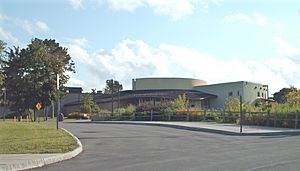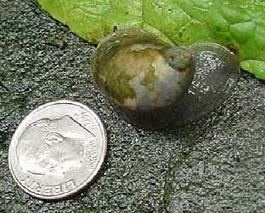Rosamond Gifford Zoo facts for kids

Rosamond Gifford Zoo logo
|
|

Main building and entrance to the zoo
|
|
| Date opened | 1914; 1986 |
|---|---|
| Location | Syracuse, New York, United States |
| Land area | 43 acres (17 ha) |
| Coordinates | 43°02′32″N 76°10′52″W / 43.04222°N 76.18111°W |
| No. of animals | 900+ |
| Memberships | AZA |
The Rosamond Gifford Zoo at Burnet Park is a fantastic zoo in Syracuse, New York. It's run by Onondaga County Parks with help from the Friends of the Zoo. This zoo is home to more than 700 animals across 43 acres of land. You can see popular animals like Asian elephants, Humboldt penguins, and Amur tigers here. The zoo also has a special center for learning about conservation, a cafe, and a gift shop.
The Rosamond Gifford Zoo has been a trusted member of the Association of Zoos and Aquariums (AZA) since 1987. This means it meets high standards for animal care and conservation.
Contents
Discovering the Zoo's History
How the Zoo Started
The zoo first opened in 1914. It was a small, four-acre place in Burnet Park. The city's parks department managed it. In 1916, the zoo began to grow. They built stone homes for bears and a pond for waterfowl. By 1933, the zoo had doubled in size. Later, in 1955, a children's zoo and a monkey exhibit were added.
Challenges and Changes
In the early 1960s, the city of Syracuse faced money problems. This meant less support for the zoo. In 1974, the zoo had a difficult time when some animals were harmed. These events made people wonder about the zoo's future.
Even though a group called Friends of the Burnet Park Zoo formed in 1970, and the city got a grant to make the zoo bigger, things changed. In 1979, the city of Syracuse gave control of the zoo to Onondaga County Parks.
A New Beginning
County Parks staff created a big plan to rebuild the zoo. The old zoo closed in 1982. A new $13 million project began in 1983. Most of the money came from the county, with the rest from the Friends of the Burnet Park Zoo.
The new zoo reopened in 1986. It quickly earned its accreditation from the Association of Zoos and Aquariums in 1987. In 1998, the zoo started a campaign to raise money for new exhibits. These included a conservation center and homes for tigers and rainforest animals. In 1999, the zoo received a large gift from the Rosamond Gifford Charitable Corporation. Because of this, the zoo was renamed the Rosamond Gifford Zoo at Burnet Park.
In the years that followed, the zoo welcomed its first lion cubs in over ten years. A special tiger trail was created for Amur tigers. A penguin exhibit opened in 2005, featuring 32 Humboldt penguins. The zoo has successfully raised many penguin chicks since then. It also became the second zoo in the U.S. to successfully raise red panda triplets! Many endangered animals have been born here, including Asian elephants, Amur tigers, Humboldt penguins, snow leopards, and red pandas.
Exploring Amazing Exhibits
U.S.S. Antiquities Aquarium
Step aboard the U.S.S. Antiquities Aquarium! This exhibit feels like a submarine trip through time. You'll see creatures from the ocean's early days to animals living on land today. The exhibits feature insects, aquatic life, reptiles, and amphibians. Look for clownfish, archerfish, and porcupine pufferfish. You can also spot poison dart frogs and Panamanian golden frogs, which are very rare. Reptiles include gila monsters, Caiman lizards, and rhinoceros iguanas.
Adaptations Exhibit
The Adaptations exhibit shows animals that have special ways of living in their natural homes. A main focus is on animals active at night. You can see North American river otters, an ocelot, fennec foxes, naked mole rats, seahorses, and Hoffmann's two-toed sloths.
Diversity of Birds Aviary
The aviary is a large, open room where birds can fly freely. It's home to warm-weather birds. You might see the bright scarlet ibis, the pink roseate spoonbill, and the beautiful Nicobar pigeon.
Social Animals and Rainforest
This exhibit features animals that live together in groups. You'll find golden lion tamarins, patas monkeys, lemurs, siamangs, meerkats, and Colobus monkeys. The zoo has had great success breeding patas monkeys. It now has the second-largest group of them in the country!
Outdoor Birds
This area shows off water birds like the Chilean flamingo and the North American wood duck. Other smaller exhibits feature laughing kookaburras, turkey vultures, and different kinds of raptors like the Eurasian eagle-owl.
Wildlife Trail
The Wildlife Trail is a half-mile path that takes you past many animals. You can see blue cranes, markhor goats, Amur tigers, red wolfs, Asian elephants, red pandas, Humboldt penguins, Andean bears, snow leopards, and more!
Asian Elephant Preserve
In 2007, plans were approved to expand the Asian elephant exhibit. This was done to help the elephant breeding program grow. The Asian Elephant Preserve was finished in 2011. It's home to the zoo's famous Asian elephant herd. The new exhibit has a big yard and a new building that can hold up to 12 elephants.
The zoo helps breed Asian elephants as part of a plan to save this endangered species. This plan is managed by the Association of Zoos & Aquariums. Seeing elephants at the zoo helps people care more about them and support conservation efforts.
Domestic Animal Barn
The Domestic Animal Barn features friendly farm animals. You can see Guinea hogs, miniature donkeys, alpacas, sheep, and goats.
Primate Park
Primate Park opened in 2010. It's an outdoor exhibit with mesh walls, swinging vines, and a waterfall. Here, you can see siamangs and patas monkeys. They take turns enjoying this fun space.
New and Updated Exhibits
The zoo is always working to make things better! They update old exhibits and build new ones. In 2013, the zoo opened a new giant Pacific octopus exhibit. This was a first for the zoo!
Helping Animals: Conservation Programs
The Rosamond Gifford Zoo is dedicated to protecting wildlife. As an accredited AZA member, conservation is a top goal. The zoo takes part in many programs to help animals and their habitats.
Species Survival Plan (SSP)
The SSP helps keep animal populations healthy and diverse. Zoos around the world work together. They lend animals to other zoos for breeding. This helps create genetically strong offspring. The Rosamond Gifford Zoo participates in SSPs for many threatened and endangered species. These include the Amur tiger, Asian elephant, Humboldt penguin, red panda, and snow leopard.
Research Program: Saving the Chittenango Snail
The Rosamond Gifford Zoo is helping to save a tiny snail called the Chittenango ovate amber snail (COAS). This snail is only found in Chittenango Falls State Park in New York. There are only about 300 of these snails left in the wild! The zoo has created a special home for them. It's a temperature-controlled terrarium that houses about 400 captive COAS. This helps protect them and learn more about them.
Other Ways the Zoo Helps
- Population Management Program (PMP): This program helps zoos manage and protect specific wild animal populations.
- Taxon Advisory Groups (TAG): These groups are made of experts. They help guide animal care, health, and conservation efforts for different types of animals.
- Conservation Action Partnership (CAP): The zoo is part of this group. It supports the work of zoos and aquariums to save wildlife.
Fun Learning: Education Programs
The Rosamond Gifford Zoo offers many exciting educational programs for all ages!
Zoo to You
This program brings the zoo to you! Professional zoo educators visit schools, libraries, and other places. They bring live animals like birds, reptiles, and insects. This program helps people learn about the animal kingdom and care for the environment.
Summer Zoo Camp
Summer Zoo Camp is an 8-week program for different age groups. Kids get to tour the zoo, do hands-on activities, play games, and make crafts. They also get to interact with animals and zoo staff!
Seasonal Camps
When school is out, kids can join School Break Zoo Camps. They can tour the zoo, see animals up close, play games, and make crafts. It's a fun way to spend a day or a whole week off from school.
EdVenture Academy
This program lets children and their parents learn more about the zoo's animals. It's designed for specific age groups. It includes crafts, snacks, and presentations with animal artifacts like skulls and feathers. You might even get to meet an animal or hear from a zookeeper!
Adult Program - Twilight at the Zoo
This special program is for adults aged 21 and over. They get to learn about the zoo and its animals. It often includes a behind-the-scenes tour of the Asian Elephant Preserve.
On-Site Educational Programs - Zoo Safari
Zoo Safari lets students learn hands-on during a field trip to the zoo. It includes an hour-long program with live animal encounters and animal artifacts. There's also a Flashlight Safari! This is an evening tour where groups explore the zoo after dark. They visit the animal diet kitchen and see animals on the Wildlife Trails at night.
Adopt an Animal
You can "adopt" any animal at the Rosamond Gifford Zoo! The money raised from this program helps the zoo in many ways. It supports improving animal homes, providing fun enrichment for animals, and funding research and training. All adopted animals stay safely at the zoo.


